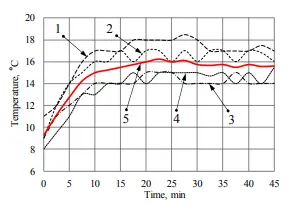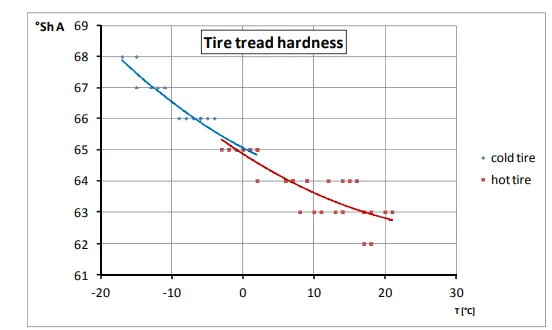The passage of time, the transition from sun to moon, the movement of the world, and the change of the seasons are some of the constant things that happen in this world. No matter what happens, these things have kept going and will keep going till the world exists.
And with the changing season, its impact on tires is visible, just like its impact on every other thing and activity of humans. Due to the climatic change, the predictability of weather and season is less accurate than it was some time ago. So, the preparation of tires for the changing conditions should be completed so the impact of weather does not affect tires immensely.
The longevity of tires depends on the conditions and weather; the tires are designed for a specific purpose, and even all-season tires are designed for particular seasons and conditions. That is why consideration and preparation for changing weather are critical to maximize the life and performance of tires.
We hardly know why different tires work in different conditions and weather, and some might even wonder if there are other tires for various conditions. That is why, to acknowledge myself and educate our readers, I have researched and gathered some information from different sources and combined them in this post.
After reading this article, you will know exactly which tires will be impacted by which weather, how the heat and hardness of the tread affect the life of the tire, and every other situation that could affect your tire longevity; this will help you get ready for any case and to prepare your tires to deal with different weather and seasons.
Table of Contents
Different Weathers and their impact on tires
Summer Weather
If you live in Florida, California, or other southern states of the US, there are chances that, at some point, you have to deal with 90°F or more. You can do nothing about the weather than change your location, which is impossible for everyone.
The hot weather obviously heats the tire; although rubber can handle the heat, everything has a limit, and tire rubber also has a heat limit. If the tire gets overheated, it could wear off, lose control, or even burst.

Based on this research, you can see that when the tire starts moving, the temperature of the tire increases rapidly; however, after 15-20 minutes at the same speed, the temperature stays stable and does not go up as rapidly as it was in the start. To maintain your tire pressure and drive at a proper temperature, try to drive at a stable speed, which keeps your tire from getting too hot and wearing off.
However, this research was based on specific weather; if your town has a higher temperature, this might not work, and the tire keeps heating even after half an hour. Because the dependent of tire temperature is based on the friction and roll of the tire, more friction at higher temperatures will definitely cause higher temperatures inside the tire.
To deal with hot weather, manufacturers have come up with summer tires; the summer tires are designed with synthetic rubber instead of natural rubber and a carbon black that keeps the tire cool even at high speed in warm weather.
So the solution for hot weather is a summer tire; although summer tires have low tread life due to the softer design, they can handle high temperatures decently and perform daily well compared to other tires.
Winter Weather
The exact opposite weather of summer is winter, and the higher temperature goes in the summer season, the lower temperature comes in winter weather. Preparing for winter weather is more important than the summer season because the dry road will be manageable to drive at a slower pace. However, the deep-standing snow will only be drivable in any situation with proper tires.
In cold weather, unlike softer treads in the summer season, the tire gets hardened in the winter season, and this picture is a perfect example of that. As you can see, when the temperature is higher, the tread hardness is also high, and as the temperature drops, the tread hardness also drops.

Even though the rugged tread is perfect for biting and excessive tread life, traction and grip are impossible with hardened tread. This is why summer tires are equipped with a more complex compound, so the temperature effect softens the tread.
For that similar reason, winter tires are equipped with a softer tread compound, so when the tread gets hardened due to the low temperature, the tire can bite the snow, properly grip, and wear normally.
Winter tires are the one and only solution for winter and cold weather. If you drive summer tires in the winter seasons, the softer tread won’t be able to bite on snow and will get stuck on the snow, unlike winter tires. That is why we always recommend our readers to keep an extra set of winter tires in their garage, and as winter goes off, replace them with regular tires to extend the life of both sets of tires.
Rainy Seasons
Spring or rainy season can also affect tire wear and performance. Rainy seasons are not warm or cold; moderate temperatures range from 60-70 F. That is why driving with either a summer or winter tire works appropriately in these situations.
The good thing about rain is that both summer and winter tires will deliver fair performance as it is at a moderate level; however, driving with these tires won’t be a good decision.
The most essential thing in the rain is grip and traction; without these things, the tire will be considered unsafe to drive. Too much rain will ruin summer tire performance, and regular rain will impact the wear of winter tires.
To deal with rainy seasons, all-season or all-weather tires are perfect, as they are not made for any extreme seasons, they can run all year round in average warm weather, mild winter seasons, and any rainy seasons.
All-season tires are built with an all-season compound consisting of some features of summer and some of winter tires, making them fair for any season and roads.
Tire Composition and Weather
Different Tire Materials
All season tires
These tires are made with synthetic and natural rubber; sometimes, they have silica in a compound, and sometimes don’t. Even though all-season tires are the most common tires nowadays, these tires can fail at any extreme temperature scale.
In extreme winter, the tread compound of the tire gets soft, which causes early wear and poor performance. Similarly, in hot, warm weather, the tire tread gets harder, which causes the tire to lose grip and deliver unstable and unsafe rides.
Although the brand, tread pattern, and material could make a difference most commonly, all-season tires are not meant for driving in extreme weather,
Summer and Winter Tires
Contrary to all-season tires, these summer and winter tires are made with the consideration of handling extreme weather properly. Summer tires are for sweltering and humid weather, and winter tires are for deep and light snow.
Summer tires’ most prominent and primary ingredients are synthetic rubber and carbon black. The purpose of carbon black is to keep the tire cool due to the hot weather and speed of a tire, and synthetic rubber is harder, which also helps in dealing with hot summer roads.
If summer tires are driven on snow, the tread gets harder, and the tire’s temperature keeps dropping, which will deliver the least traction and grip on snow, and the tire will be ruined after 2-3 trips.
Winter tires are equipped with natural rubber and a silica compound, which makes them softer than summer tires and gets hotter when dealing with hot weather; that is why winter tires are not meant to be driven in hot weather cause they will lose their tread after the first ride. The silica compound helps on snow as it helps in biting the snow and provides proper traction and grip.
Tread Patterns
To utilize the complete life of the tire, you should avoid any impact on the tire or its tread from weather or conditions. The tread designs of different tires are made for their respective weather. The winter tire treads are deep, with multiple sipes, grooves, and open shoulder designs, and usually in an asymmetrical pattern.
The summer heat can cause this deep design to fail without utilizing it. While on snow, these tires can channel water and ice through the tread, bite deep into the snow, and achieve proper grip with the help of sipes to deliver an adequate driving experience.
The treads of summer tires are usually symmetrical, have fewer sipes and grooves, and have shallow treads because the purpose of summer tires is not to bite snow or channel water. The goal of summer tires is to manage the heat a tire creates and deliver proper cornering and grip on faster tracks, which are impossible with deep tread.
This tread pattern on winter terrains will move your car like you are sitting in a boat, with no response through handling and an imbalance ride. That is how tread patterns and designs are prominent regarding weather and tire longevity.
Maintenance Practices
Regular Inspections
Signs of tear from weather impact on tires are easily visible; early wearing of tread, more force to move, rolling resistance, and impaired performance are signs of weather-related problems on tires. Other factors contribute to these issues, but they will likely be related to changing weather, so as the temperature drops or increases, change your tires to the recommended tires.
A weekly or monthly quick inspection of tires makes these wear find out earlier than it causes some big trouble, so also make sure to give importance to your tires.
Proper Inflation
There is science that when temperature changes, the air pressure on the tire also changes due to air passing through rubber and moisture. It is proven that for every drop in 10 degrees F, 1-2 PSI will be lost from your tires. It is something other than what could affect the performance; however, if the tires are already underinflated, this might impact your tires.
You can also read in detail how over and under-inflated tires impact your drive in the short and longer terms. So, inspect the air pressure regularly with a manual gauge at least once weekly.
Storage and Seasonal Changes
Seasonal Swaps
If the temperature drops below 45°F, switching to winter tires is the best decision, significantly if a further drop in weather is predicted. Similarly, if the temperature is between 45°F- 70°F, all-season or summer tires can be used. However, above 70°F, summer tires will be the most prominent to deal with this much heat.
The seasonal swaps are the best thing that you can do with both of your tire sets; if you store each set of tires and replace them timely, you will be able to achieve the best out of both of these tires, which would not be possible if you keep driving with summer tires on winter season and wait till it wears off completely.
Off-season Storage
Clean and Inspect: Before storing your tires, ensure they are clean and free of debris, dirt, and water, as they can leave their mark on tires forever.
Proper Location: Store your tires in a cool, dry, and away from sunlight, as UV lights impact tires’ durability.
Elevate and Stack: storing tires horizontally above each other is a better way to avoid any tread damage. If stacking vertically, prevent the tread from the surface, as it can unshape it.
Pressure Check: maintain the tire air pressure at the recommended level when storing tires, as over and under-inflated tires can damage the tread life.
Seal and Cover: Use airtight plastic bags or tire storage covers to protect against dust and moisture. Avoid using plastic sheets that do not allow the tires to breathe, which can lead to moisture buildup.
Conclusion
Utilizing the total tire life, you have to consider weather impact on tires and their treads as we discuss how tires lose performance and durability and become unsafe just as the weather changes. Every tire is built for its recommended situation and temperature, and driving a specific tire to its particular conditions improves the experience and tire life.
We hope that you understand the importance of temperature and its impact on tires and that you will choose to replace tires as the season changes. If you do not have a garage to keep a second set of tires, keep them in any tire service shop that charges you a small fee, or you buy a tire storage rack that will keep a small space in your yard. However, it will be a more economical decision in the long run.
